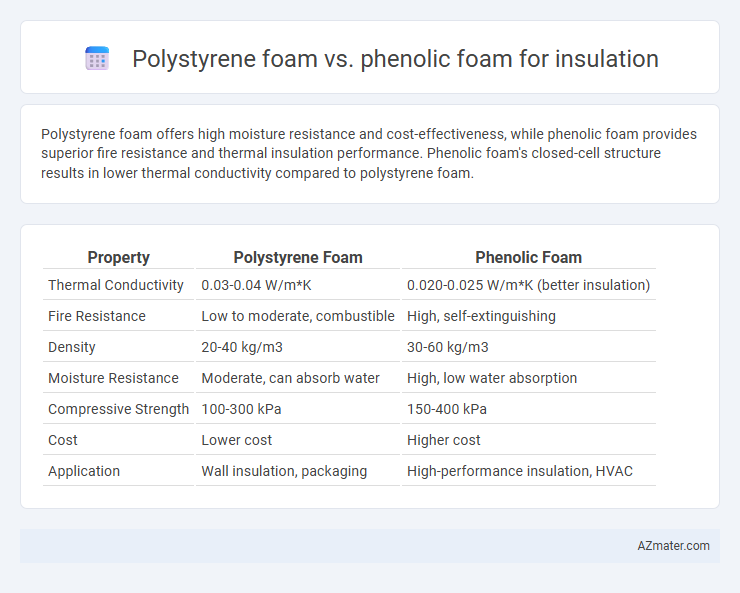Polystyrene foam offers high moisture resistance and cost-effectiveness, while phenolic foam provides superior fire resistance and thermal insulation performance. Phenolic foam's closed-cell structure results in lower thermal conductivity compared to polystyrene foam.
Table of Comparison
| Property | Polystyrene Foam | Phenolic Foam |
|---|---|---|
| Thermal Conductivity | 0.03-0.04 W/m*K | 0.020-0.025 W/m*K (better insulation) |
| Fire Resistance | Low to moderate, combustible | High, self-extinguishing |
| Density | 20-40 kg/m3 | 30-60 kg/m3 |
| Moisture Resistance | Moderate, can absorb water | High, low water absorption |
| Compressive Strength | 100-300 kPa | 150-400 kPa |
| Cost | Lower cost | Higher cost |
| Application | Wall insulation, packaging | High-performance insulation, HVAC |
Introduction to Polystyrene and Phenolic Foam Insulation
Polystyrene foam insulation, available in expanded (EPS) and extruded (XPS) forms, offers excellent thermal resistance with an R-value ranging from 3.6 to 5 per inch, making it a popular choice for walls, roofs, and foundations. Phenolic foam insulation features a closed-cell structure with superior fire resistance and a higher R-value around 4.2 to 5.0 per inch, providing enhanced thermal performance and smoke suppression in building applications. Both materials are lightweight and moisture-resistant, but phenolic foam's low smoke emission and higher dimensional stability give it advantages in fire safety and long-term durability.
Composition and Manufacturing Processes
Polystyrene foam consists primarily of polymerized styrene monomers formed through a bead or extrusion process that creates closed-cell structures ideal for thermal insulation. Phenolic foam is produced by the reaction of phenol and formaldehyde, resulting in a rigid, highly cross-linked polymer network formed via a foaming process using blowing agents, offering superior fire resistance and low smoke emission. The manufacturing of polystyrene foam involves expandable beads or extrusion with steam expansion, while phenolic foam uses chemical foaming agents during polymerization, yielding a denser and more thermally stable material.
Thermal Insulation Performance Comparison
Polystyrene foam offers moderate thermal insulation with an R-value typically ranging from 3.6 to 4.2 per inch, making it suitable for a variety of insulation applications. Phenolic foam delivers superior thermal performance, boasting an R-value around 4.5 to 4.8 per inch, which enhances energy efficiency in demanding insulation environments. The lower thermal conductivity of phenolic foam also provides improved resistance to heat transfer compared to polystyrene, making it the preferred choice for high-performance insulation systems.
Fire Resistance and Safety Considerations
Polystyrene foam, including expanded (EPS) and extruded (XPS) types, offers moderate fire resistance but tends to emit toxic gases and dense smoke when ignited, requiring the use of fire-retardant additives or protective barriers in building insulation applications. Phenolic foam stands out for its superior fire resistance with a higher limiting oxygen index (LOI) around 27-33%, self-extinguishing properties, and low smoke emission, making it a safer choice in fire-critical environments. Safety considerations also highlight phenolic foam's excellent structural integrity at elevated temperatures, reducing the risk of combustion and toxic fume release compared to polystyrene-based foams.
Moisture and Water Vapor Resistance
Polystyrene foam exhibits excellent moisture resistance due to its closed-cell structure, effectively minimizing water absorption and maintaining insulating properties in wet conditions. Phenolic foam also offers strong water vapor resistance with low permeability but can absorb more moisture over time compared to polystyrene, potentially reducing its thermal efficiency. For applications requiring long-term exposure to high humidity or water, polystyrene foam provides more reliable moisture control and durability.
Compressive Strength and Structural Integrity
Polystyrene foam offers moderate compressive strength, typically ranging from 20 to 60 psi, making it suitable for applications requiring lightweight insulation with reasonable load-bearing capacity. Phenolic foam provides superior compressive strength, often exceeding 70 psi, coupled with excellent structural integrity due to its rigid and thermosetting polymer matrix. The enhanced mechanical properties of phenolic foam contribute to better dimensional stability and long-term performance in insulation systems exposed to higher mechanical stresses.
Environmental Impact and Sustainability
Polystyrene foam, widely used for insulation, is derived from petroleum and presents challenges in recycling due to its non-biodegradable nature and potential release of toxic chemicals during disposal. Phenolic foam, made from phenol-formaldehyde resin, offers superior fire resistance and lower global warming potential, with better biodegradability and potential for recycling, making it a more sustainable choice. Considering lifecycle assessments, phenolic foam exhibits reduced environmental impact through lower greenhouse gas emissions and improved resource efficiency compared to polystyrene foam.
Installation Methods and Ease of Use
Polystyrene foam insulation is typically installed using adhesive bonding or mechanical fasteners, allowing for quick placement and cutting with standard tools, which makes it highly user-friendly for DIY projects. Phenolic foam, while offering superior fire resistance and thermal performance, requires more precise handling due to its brittleness and often necessitates professional installation to ensure seamless fitting and adhesion. Both materials benefit from vapor barriers, but polystyrene's rigidity provides easier customization on-site, whereas phenolic foam's panelized form demands meticulous alignment for optimal insulation efficiency.
Cost Analysis and Economic Factors
Polystyrene foam offers lower upfront costs compared to phenolic foam, making it a preferred choice for budget-conscious insulation projects, but its thermal performance is typically lower. Phenolic foam, while more expensive initially, provides superior fire resistance and higher insulation value, contributing to long-term energy savings and reduced maintenance costs. Economic factors such as lifecycle cost, installation expenses, and regional availability influence the decision, with phenolic foam often favored in applications demanding stringent fire safety standards despite its higher price point.
Best Applications and Suitability for Projects
Polystyrene foam excels in insulating walls, roofs, and foundations due to its water resistance and high compressive strength, making it ideal for residential and commercial building projects with moisture exposure. Phenolic foam offers superior fire resistance and thermal performance, suitable for industrial applications, cold storage, and environments requiring stringent fire safety standards. Choosing between the two depends on project-specific needs such as moisture conditions, fire regulations, and insulation efficiency requirements.

Infographic: Polystyrene foam vs Phenolic foam for Insulation
 azmater.com
azmater.com